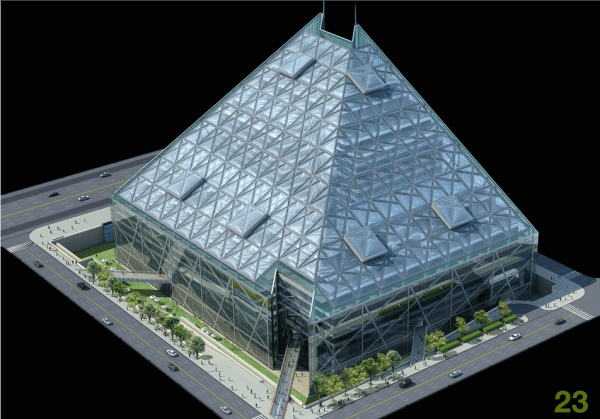The question of how regulate indoor air temperatures is a big one in green building, as the energy used to heat and cool a building tends to claim the lion’s share of its carbon footprint. There are many green strategies for tackling this question, from technological fixes like radiant, in-floor heat coupled with a solar thermal system to your basic passive solar design. But Beijing’s Parkview Green FangCaoDi (which comes to us via Inhabitat) is the first we’ve seen to actually use a dedicated external structure as a buffer.
Not unlike a bio-dome, Parkview Green makes use of a sealed envelope composed of glass and ETFE (Ethylene Tetrafluoroethylene, a transparent polymer that is used instead of glass and plastic in many modern buildings) to provide a thermal buffer for the structures within, reducing the need for heating in the winter and AC in the summer. This large glass pyramid structure completely encases two nine-storey and two 18-storey towers containing an office space, a six-star hotel and retail facilities.

Specially designed louvers at the top of the pyramid provide a place for hot air to escape while ushering fresh air into the building, offering natural ventilation and free cooling whenever outside temps are amenable. By creating a buffer zone in the form of a controlled microclimate — in which the temperature and humidity is pretty much uniform and easily changed by tweaking a variable or two — this 800,000 square foot development is able to control temperatures within the towers with a bare minimum of energy expended.
This building/hotel/shopping and commercial hub — designed by Integrated Design Associates and engineered by ARUP — makes use of other sustainable strategies as well. Among them, ground source geothermal wells coupled with a heat exchanger, which seems appropriate: just as the geothermal system relies on the buffer of the earth to keep temperatures below ground around 55 degrees, the Parkview building relies on the buffer of its external glass “skin” to keep temperatures within the building from spiking or dipping too low.

Used in conjunction with one another, these two sustainable strategies keep energy expenditures to the bare minimum keep year round, saving 60 percent on cooling costs in the summer and 80 percent on heating in the winter.
The development also harvests rainwater from its roof and paved areas, which is then filtered, recycled and used to irrigate native, drought-reistant plants in the surrounding landscape. (Greywater from the building’s sinks, showers and faucets is also reclaimed and put to work in this way.) Sustainable/recycled building materials were used throughout.
In recognition of its excellence as a green building, Parkview Green has received LEED certification at the Platinum certification from the U.S. Green Building Council.